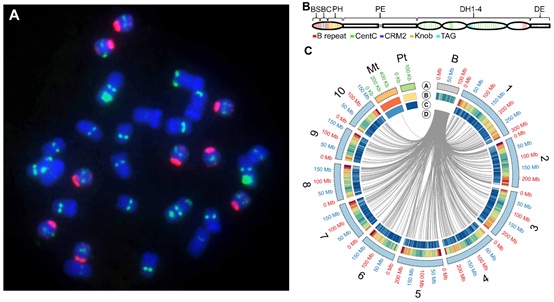
Three groups (Dr. James Birchler’s group from University of Missouri, Dr. Jan Barto’s group from Institute of Experimental Botany of the Czech Academy of Sciences and Dr. HAN Fangpu’s group from the Institute of Genetics and Developmental Biology of the Chinese Academy of Sciences) recently reported a reference sequence for the supernumerary B chromosome in maize in a study published online in PNAS (doi:10.1073/pnas.2104254118).
Supernumerary B chromosomes persist in thousands of plant and animal genomes despite being nonessential. They are maintained in populations by mechanisms of “drive” that make them inherited at higher than typical Mendelian rates. Key properties such as its origin, evolution, and the molecular mechanism for its accumulation in maize have remained unclear even though such chromosomes have been a potent tool for studying maize genetics.
The researchers used a well-established set of sequencing and mapping tools, including chromosome flow-sorting, Illumina sequencing, Bionano optical mapping, and chromatin conformation capture (Hi-C).
The rich availability of deletion derivatives ensured strong scaffolding and vetting of assembly. In addition, 758 protein-coding genes were identified from the 125.9-Mb of chromosome sequence, of which at least 88 are expressed.
The scientists discovered that the current gene content is a result of continuous transfer from the A chromosomal complement over an extended evolutionary period. This process has been accompanied by subsequent degradation even though selection for maintenance of this nonvital chromosome has also continued.
The annotation results demonstrate that transposable elements in the B chromosome are shared with the standard A chromosome set. However, the failure of multiple lines of evidence to reveal a syntenic region in the B chromosome with any A chromosome indicates that this chromosome has been present in the evolutionary lineage for millions of years since any such synteny has disintegrated.
Sequence and deletion analysis reveals that a specific DNA repeat is located in and around the centromere that is involved with its drive mechanism, consisting of nondisjunction at the second pollen mitosis and preferential fertilization of the egg by the B-containing sperm.
This analysis cleverly combines comparisons among a variety of translocation and B-deletion stocks along with many years of genetic analysis. This approach provides a unique view of the sequence of this chromosome, as well as characterization of potentially functional elements within it.


86-10-68597521 (day)
86-10-68597289 (night)

52 Sanlihe Rd., Xicheng District,
Beijing, China (100864)

